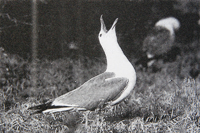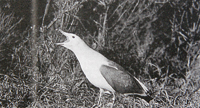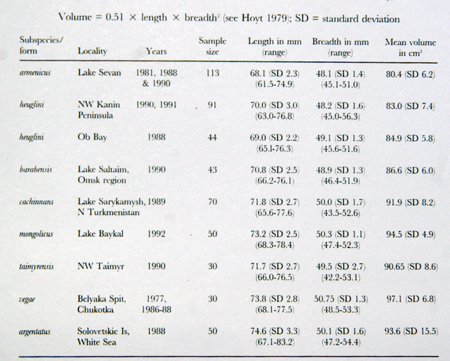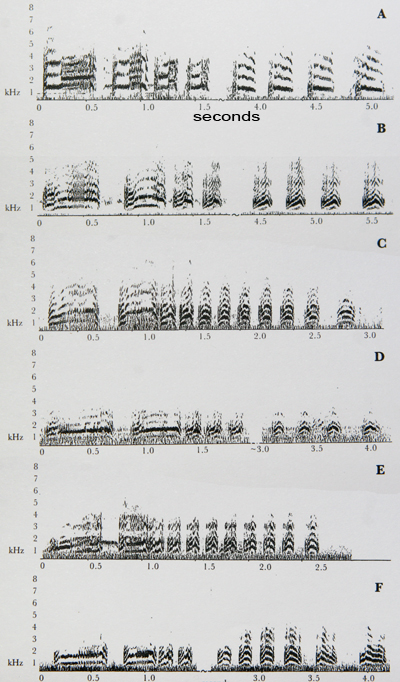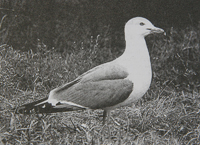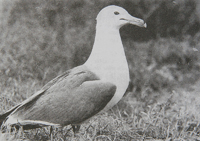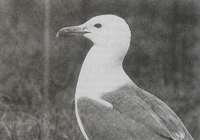 Larus armenicus
Larus armenicus
(last update:
| 4cy / sub-adult armenicus: January
Interest in the Armenian Gull Larus (argentatus) armenicus* has increased dramatically since the realisation that this gull showed a characteristic black band on the bill (e.g. Geroudet 1982; Hume 1983; Cramp & Simmons 1983; Dubois 1985; Grant 1988; Satat & Laird 1992). The uniqueness of this character among Palearctic forms of the species/subspecies complex that includes Herring L. argentatus, Yellow-legged L. cachinnans and Lesser Black-backed Gulls L. fuscus (hereafter referred to as ‘the complex`) was one of the reasons that led P. Devillers (Devillers & Potvliege 1981; Devillers 1985) and others (e.g., J. Haffer in Glutz von Blotzheim & Bauer 1982) to consider the Armenian Gull a full species. This approach remains debatable, however, owing to the paucity of morphological descriptions and eco-ethological observations from the breeding grounds. Such data are limited to the initial scientific description of this form from Lake Sevan, Armenia (Buturlin 1934a), and brief accounts of its distribution and breeding ecology, mainly from the same place, summarised in regional avifaunistic reviews (Lyaister & Sosnin 1942; Dahl 1954). More recently, only Airumyan el al. (1974) have referred, briefly, to these gulls at Sevan. On 13th-14th June 1990, I visited a colony of Armenian Gulls at Sevan, a lake situated in a mountain valley at 1,900 m above sea level. Studies of phenotypic and behavioural parameters were carried out from a hide at two points within the colony, and during two walks across the colony to ring 200 young. Observations were facilitated by the fair degree of tolerance the gulls showed towards a human intruder: when 1 remained motionless, they quickly landed at a distance of 5-15 m and made rapid contact with their young. ---------------------------------- History and ecology of Armenian colonies In the first third of this century, Armenian Gulls bred at several places along Lake Sevan shore and on swamp lowlands nearby. Nests were built in various habitats, including cliffs, reedbeds, sand beaches and even agricultural fields (Lyaister & Sosnin 1942). The gulls were considered to damage fisheries and were therefore persecuted by local inhabitants. Their eggs were also harvested for food (Lyaister & Sosnin 1942; Airumyan el al. 1974).
The situation has since improved greatly. In June 1990, I estimated that about 3,000 pairs were nesting on one island and about 1,000 on the other. The colony not only occupied the islands, but also extended to the nearby shore, where a few tens of pairs were breeding. The islands have recently been included within the Sevan National Park boundary. Away from Lake Sevan, colonies of Armenian Gulls are known in Armenia only on Arpilich lake (4l° 05'N, 43° 40'E), referred to as Lake Arpa by Suter (1990), where gulls nest also on islands and in even larger numbers than at Sevan. These colonies first appeared in the mid 1970s (S. O. Petrosyan, verbally). This gull`s Armenian population seems currently, therefore, in view of the high number of breeders, to be in a healthy state. These high local concentrations, however, probably linked to the scarcity of suitable breeding sites protected from terrestrial predators and human beings, make the population vulnerable to chance factors. Breeding biology and behaviour
V. V. Leonovich, who visited the islands on 27th and 30th April 1990, pointed out (verbally) that egg-laying was in full swing at that time: on 27th, many pairs which had finished building had not yet laid or had incomplete clutches, and at only a few nests were eggs already being incubated; three days later, the number of nests without eggs or with incomplete clutches had obviously decreased and most pairs had full clutches of three eggs. When I visited in mid June, only two clutches were still being incubated, while the majority of nestlings were 15-25 days old. This indicates that, in 1990, the peak period of laying occurred in the last ten days of Apri1: i.e. 10-15 days later than in Black Sea and southern Caspian Sea colonies (of Yellow-legged Gulls) in years with normal weather conditions (Dyunin 1948; Kostin 1983; pers. obs.).
The social situation in the colony was rather tense. During my observations, territorial conflicts were not unusual and were occasionally accompanied by prolonged lighting. Adults were sometimes seen to peck at and kill stray nestlings, which they partly ate.
The voice of the Armenian Gull is quite shrill and hoarse, and not so melodious as that of the Herring Gull. As shown by sonograms (fig. l), the harmonic structure of the Long Call resembles that of gulls of the cachinnans-fuscus part of the complex. The Long Call is uttered hurriedly, even excitedly, as with cachinnans. A characteristic feature of the Lake Sevan Armenian Gulls was that they regularly held their wings in a somewhat lowered, relaxed position (plates 213, 214 & 215). In other gulls of the complex, such a position is observed mainly in agonistic situations, or when the air temperature is higher. At Sevan, it was the usual position even in obviously calm situations without any social contacts, and at any time in the day, including the cool morning and evening hours. Structure, plumage and bare-part variations Structural traits such as a comparatively rounded head, blunt-ended bill, short neck (in flight) and others, noted as inconstant or variable on Armenian Gulls in winter quarters (cf Grant 1988 and Satat & Laird 1992), were typical of Sevan birds. Taken in combination, they can be very helpful for distinguishing Armenian Gulls in the field elsewhere.
All breeding birds had yellow to bright yellow legs and a red or orange-red orbital ring. Iris colour varied from dark brown to pale yellowish: on many individuals (at least six out of 44, from photographs) the iris was pale enough to contrast with the pupil, and in rare cases had no dark pigment (plates 213, 214 & 215). Bill pattern, too, was variable. Of 51 gulls examined closely, 33 had an unbroken black band on the upper mandible and a black spot in front of the red spot on the lower mandible, with some variation in the width of the band and the size of the spot. On another 16, the band was more or less reduced to a tiny spot on the upper mandible, again with much individual variation. Two had no black at all on the bill. Band pigment was of variable intensity, and was sometimes more grey than black. A red spot at the gonydeal angle was present on all birds, often extending to the upper mandible.Discussion
A very puzzling fact is that the black bill band, now seen to be present on a large majority of breeders, was not mentioned either in the initial description of this form (Buturlin 1934a), or by other authorities of that time who saw at least some of the type-series specimens (e.g. Stegmann 1934) and observed many Armenian Gulls alive (Dahl & Sosnin 1947). It seems probable that Buturlin and others had good reasons not to include this character in their descriptions; if so, this suggests that the bill band was not so common in the earlier Sevan population, or was less distinctive than it is now. This is supported by examination of those specimens from the type-series (collected in 1923-28 by G. V. Sosnin: see Buturlin 1934a) which are deposited in the Zoological Museum of the Moscow State University. A wide black band is visible only on one female showing traces of immature plumage (probably a three-year-old). Of three adults in full plumage, one shows no dark pigmentation on the bill; the other two, including the type specimen, show dark (not black) lines and diffuse spots on the bill, which may have been present on the living birds, but which may also, quite naturally, be linked to skin-drying. The detailed bill patterns of other specimens in old collections that include type-series, which are deposited in Erevan (Institute of Zoology) and St Petersburg (Zoological Institute), are not known to me. In some cases, however, black is absent or markedly reduced (S. O. Petrosyan and P. Yésou in litt.). It appears, therefore, that dark bill markings may already have been present on breeding birds in the 1920s and before, but that they may at that time have been considered to be traces of immaturity or to have resulted from skin-drying. In any event, the frequency of such markings was much lower than it is now. A possible explanation for this discrepancy, suggested by P. Yésou (verbally), is that the markings may be related to age: they should tend to be absent on the older adults which predominate in a stable or decreasing population, as was the case in the 1920s, but should be more or less marked on younger adults, which must now account for a large proportion of breeders.
Iris colour, too, appears to vary seasonally. It is usually dark and only occasionally yellowish in winter (Satat & Laird 1992), whereas a reduction in dark pigment is commoner on the breeding grounds. Such seasonal change in bare-part coloration may seem a very odd phenomenon to West European ornithologists and birdwatchers, as adults of West European forms of either Herring, Yellow-legged or Lesser Black-backed Gulls are not known to exhibit any change in iris colour, and the occasional dark bill band — found more commonly on Lesser Black-backed, but also on Herring and Yellow-legged Gulls— is usually considered a sign of immaturity (Grant 1986). Iris colour may, however, be more variable (at least in breeding areas), and dark bill markings in winter can develop regularly on adults of other Asian forms, particularly within the heuglini-taimyrensis-barabensis group (Hirschfeld 1992; Yésou & Filchagov in prep.; see also photograph in Madge 1992 of two gulls labelled ‘probably of the subspecies cachinnans’, which in fact look like typical barabensis). Dark bill pigmentation also occurs commonly in winter on adult Glaucous-winged Gulls L. glaucescens (Vermeer 1963). Furthermore, in some Asian populations, small dark markings on the bill, mostly on the upper mandible, are frequently found on breeding birds in full adult plumage: for example, on 18 out of 29 barabensis from the Omsk region examined in the hand (pers. obs.). The Armenian Gull, by virtue of its comparatively small size, certain phenotypical characters of adults (extensive dark on primaries, leg and orbital-ring colours, dark mantle) and its Long Call vocalisation and display, is related to the cachinnans-fuscus group of the northern Palearctic, and seems closer to barabensis and heuglini. Its present breeding distribution, restricted to mountain lakes, may be of a relict nature, though this is merely supposition and other scenarios cannot be excluded (e.g., that a northern ancestral form emigrated to mountain lakes, where it found a suitable environment). Our suggestion that the Armenian Gull is linked to the northern forms through barabensis accords with the idea already developed by Buturlin (1934b) and again, recently, by Bourne (1989). Further studies are needed, permitting a more objective assessment of genealogical relationships and, particularly, the taxonomic status of the Armenian Gull. With our present state of knowledge, the only basis for the promotion of the Armenian Gull to a full species, Larus armenicus, appears to be its geographical isolation: a rather weak basis in systematics. Acknowledgments 1 am much obliged to E. G. Zakharyan, Director of the Sevan National Park, for his help in organising my fieldwork. I gratefully thank my older colleagues. S. O. Petrosyan and V. V. I.eonovich, whose information and data were very useful for this paper. I thank Dr P. Tomkovich, who permitted me to work with the ornithological collection of the Zoological Museum of Moscow State University, and Dr A. A. Nikolsky and A. B. Vasilyeva for their help with sonographic analysis. Particular thanks are due to P. Yésou, who acquainted me with the latest papers and articles on the Armenian Gull and helped to improve significantly the manuscript. Summary On 13th-14th June 1990, observations were made at Lake Sevan, Armenia, on phenotypic traits, breeding and behaviour of the Armenian Gull Larus (argentatus) armenicus. Historical and ecological data on Sevan colonies are reviewed. The black bill band as well as iris colour were variable on breeders. Black markings on the bill are now the most distinctive feature of the Armenian Gull, but their occurrence seems to have been much less frequent 60-70 years ago than nowadays. Certain phenotypic characters of adults and Long Call display and vocalisation indicate that the Armenian Gull is related to the cachinnans-fuscus group of gulls of the northern Palearctic. References A |
 Larus armenicus sub-adult January 29 2011, University zool garden, Tel Aviv, Israel. Picture: Amir Ben Dov. Larus armenicus sub-adult January 29 2011, University zool garden, Tel Aviv, Israel. Picture: Amir Ben Dov. |
|||||
 Filchagov, A.V. (1993): The Armenian Gull in Armenia. British Birds 86: 550-560.
Filchagov, A.V. (1993): The Armenian Gull in Armenia. British Birds 86: 550-560. 